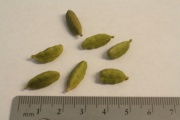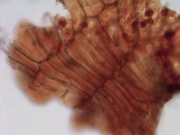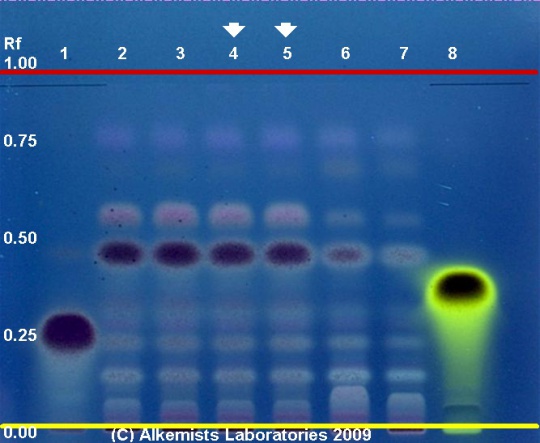Elettaria cardamomum (fruit)
m |
|||
| Line 50: | Line 50: | ||
=HPTLC Entries= | =HPTLC Entries= | ||
| + | {{HPTLC | source=Elan M. Sudberg, Alkemist Laboratories | ||
| + | | description=Cardamom (seed) (''Elettaria cardamomum'' L. Maton) | ||
| + | | companyimage=AP-LOGO-Laboratories Crop - Copy.jpg | ||
| + | | companyURL=http://www.alkemist.com | ||
| + | | mainimage=Elettaria_cardamomum_-_Alkemists_Laboratories.jpg | ||
| + | | caption1="Elettaria cardamomum" L. Maton (seeds) HPTLC UV 365 nm | ||
| + | | stationaryphase=Silica gel 60, F254, 10 x 10 cm HPTLC plates | ||
| + | | mobilephase=toluene: ethyl acetate [9.5/0.5] | ||
| + | | prep=0.5g+5ml dichloromethane, sonicate/centrifuge/decant, evaporate to dryness with N2, qs with 1.0 ml Toluene | ||
| + | | detection=Vanillin/H2SO4 Reagent -> 110° C 5 min -> UV 365 nm | ||
| + | | lanes=Lane 1 (1μl) Linalool ~0.1% in methanol; Lane 2(2μl) ''Elettaria cardamomum'' L. Maton-1 (seed)(Guatemala); Lane 3(2μl) ''Elettaria cardamomum'' L. Maton-2 (seed)(Guatemala); Lane 4(2μl) ''Elettaria cardamomum'' L. Maton-3 (seed), Lane 5(2μl) ''Elettaria cardamomum'' L. Maton-3 (seed); Lane 6(2μl) ''Elettaria cardamomum'' L. Maton-4 (seed), Lane 7(1μl) ''Elettaria cardamomum'' L. Maton-4 (seed; Lane 8 (3μl) Eugenol~0.1% in methanol, these references have been authenticated by macroscopic, microscopic &/or TLC studies according to the reference sources cited below held at Alkemists Laboratories, Costa Mesa, CA. | ||
| + | | reference=Medicinal Spices, Teuscher, E., 2006, CRC Press or The Ayurvedic Pharmacopoeia of India Part I Volume I | ||
| + | | }} | ||
=Other Points of Interest= | =Other Points of Interest= | ||
Revision as of 23:08, 19 October 2012
Contents |
Introduction
Introduction from Wikipedia, the free encyclopedia (http://en.wikipedia.org/wiki/Elettaria, retrieved 02/27/2012).
Elettaria is a genus of one or two species of cardamoms, native to southeastern Asia from India south to Sri Lanka and east to Malaysia and western Indonesia, where it grows in tropical rainforests.
It is a pungent aromatic herbaceous perennial plant growing to 2–4 m in height. The leaves are alternate in two ranks, linear-lanceolate, 40–60 cm long, with a long pointed tip. The flowers are white to lilac or pale violet, produced in a loose spike 30–60 cm long. The fruit is a three-sided yellow-green pod 1–2 cm long, containing several black seeds.
The quoted text in this section was licensed for use under the Creative Commons ShareAlike License, version 3.0: http://creativecommons.org/licenses/by-sa/3.0/
Macroscopic Entries
|
Microscopic Entries
|
|
HPTLC Entries
|
Cardamom (seed) (Elettaria cardamomum L. Maton) Lane Assignments Lane 1 (1μl) Linalool ~0.1% in methanol; Lane 2(2μl) Elettaria cardamomum L. Maton-1 (seed)(Guatemala); Lane 3(2μl) Elettaria cardamomum L. Maton-2 (seed)(Guatemala); Lane 4(2μl) Elettaria cardamomum L. Maton-3 (seed), Lane 5(2μl) Elettaria cardamomum L. Maton-3 (seed); Lane 6(2μl) Elettaria cardamomum L. Maton-4 (seed), Lane 7(1μl) Elettaria cardamomum L. Maton-4 (seed; Lane 8 (3μl) Eugenol~0.1% in methanol, these references have been authenticated by macroscopic, microscopic &/or TLC studies according to the reference sources cited below held at Alkemists Laboratories, Costa Mesa, CA. Stationary Phase Silica gel 60, F254, 10 x 10 cm HPTLC plates Mobile Phase toluene: ethyl acetate [9.5/0.5] Sample Preparation Method 0.5g+5ml dichloromethane, sonicate/centrifuge/decant, evaporate to dryness with N2, qs with 1.0 ml Toluene Detection Method Vanillin/H2SO4 Reagent -> 110° C 5 min -> UV 365 nm Reference see Medicinal Spices, Teuscher, E., 2006, CRC Press or The Ayurvedic Pharmacopoeia of India Part I Volume I
|
Other Points of Interest
Cite error: <ref> tags exist, but no <references/> tag was found




